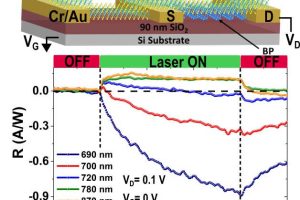As a back-end process over CMOS, the team fabricated a p-n junction with an infra-red bandgap from a bi-layer of the two-dimensional dichalcogenide MoTe2.
“Researchers have been trying to find materials that are compatible with silicon, in order to bring optoelectronics and optical communication on-chip, but so far this has proven very difficult,” said scientist Pablo Jarillo-Herrero. “For example, gallium arsenide is very good for optics, but it cannot be grown on silicon very easily because the two semiconductors are incompatible.” In contrast, he added, 2-D molybdenum ditelluride can be mechanically attached to any material.
The p-n junction in the proof-of-concept device is a little unconventional.
Rather than doping its layers, a voltage applied across metallic gate electrodes side-by-side on top of the MoTe2 makes the junction. Current through the device then causes light to be emitted.
The same device with the bias potential reversed stops conduction, until light shines on the junction, according to MIT.
“That is a significant breakthrough, because it means we do not need to introduce chemical impurities into the material, we can do it electrically,” said Jarillo-Herrero.
The light is at 1.1μm, which is not absorbed by silicon and is therefore suitable for intra-chip communications.
However, this is not suitable for telecoms whose glass fibres require either 1.3 or 1.5μm, so team is investigating a graphene-like allotrope of phosphorus called ‘black phosphorus’, which can be tuned to emit light at different wavelengths by altering the number of layers. “They hope to develop devices with the necessary number of layers to allow them to emit light at the two wavelengths while remaining compatible with silicon,” said the university.
The work is published in Nature Nanotechnology as ‘A MoTe2-based light-emitting diode and photodetector for silicon photonic integrated circuits‘.
 Electronics Weekly Electronics Design & Components Tech News
Electronics Weekly Electronics Design & Components Tech News



